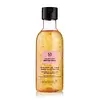What's inside
What's inside
 Key Ingredients
Key Ingredients

No key ingredients
 Benefits
Benefits

 Concerns
Concerns

No concerns
 Ingredients Side-by-side
Ingredients Side-by-side

Water
Skin ConditioningPropanediol
SolventMethyl Gluceth-20
HumectantPPG-26-Buteth-26
Skin ConditioningGlycerin
HumectantPEG-40 Hydrogenated Castor Oil
EmulsifyingPhenoxyethanol
PreservativeAcrylates/C10-30 Alkyl Acrylate Crosspolymer
Emulsion StabilisingParfum
MaskingEthylhexylglycerin
Skin ConditioningCaprylhydroxamic Acid
Rosa Gallica Flower Powder
Skin ConditioningPanthenol
Skin ConditioningSodium Hydroxide
BufferingMethylpropanediol
SolventTrisodium Ethylenediamine Disuccinate
Rose Extract
Skin ConditioningPEG-30 Dipolyhydroxystearate
EmulsifyingTrideceth-6
EmulsifyingBenzyl Salicylate
PerfumingAloe Barbadensis Leaf Juice Powder
Skin ConditioningLimonene
PerfumingBenzyl Alcohol
PerfumingCitronellol
PerfumingGeraniol
PerfumingAlpha-Isomethyl Ionone
PerfumingLinalool
PerfumingCitric Acid
BufferingSodium Benzoate
MaskingPotassium Sorbate
PreservativeWater, Propanediol, Methyl Gluceth-20, PPG-26-Buteth-26, Glycerin, PEG-40 Hydrogenated Castor Oil, Phenoxyethanol, Acrylates/C10-30 Alkyl Acrylate Crosspolymer, Parfum, Ethylhexylglycerin, Caprylhydroxamic Acid, Rosa Gallica Flower Powder, Panthenol, Sodium Hydroxide, Methylpropanediol, Trisodium Ethylenediamine Disuccinate, Rose Extract, PEG-30 Dipolyhydroxystearate, Trideceth-6, Benzyl Salicylate, Aloe Barbadensis Leaf Juice Powder, Limonene, Benzyl Alcohol, Citronellol, Geraniol, Alpha-Isomethyl Ionone, Linalool, Citric Acid, Sodium Benzoate, Potassium Sorbate
Ingredients Explained
These ingredients are found in both products.
Ingredients higher up in an ingredient list are typically present in a larger amount.
Panthenol is a common ingredient that helps hydrate and soothe the skin. It is found naturally in our skin and hair.
There are two forms of panthenol: D and L.
D-panthenol is also known as dexpanthenol. Most cosmetics use dexpanthenol or a mixture of D and L-panthenol.
Panthenol is famous due to its ability to go deeper into the skin's layers. Using this ingredient has numerous pros (and no cons):
Like hyaluronic acid, panthenol is a humectant. Humectants are able to bind and hold large amounts of water to keep skin hydrated.
This ingredient works well for wound healing. It works by increasing tissue in the wound and helps close open wounds.
Once oxidized, panthenol converts to pantothenic acid. Panthothenic acid is found in all living cells.
This ingredient is also referred to as pro-vitamin B5.
Learn more about PanthenolPeg-40 Hydrogenated Castor Oil is derived from castor oil and polyethylene glycol (PEG). It is used as a emollient and emulsifier.
As an emulsifier, it helps prevent ingredients from separating. It also helps make the other ingredients more soluble; it is often used to solubilize fragrances. This increases spreadability and elongates shelf life in a product.
Emollients help soothe and soften the skin. They do this by creating a protective film on your skin. This barrier helps trap moisture and keeps your skin hydrated. Emollients may be effective at treating dry or itchy skin.
This ingredient may or may not be vegan, depending on the source.
Peg-40 Hydrogenated Castor Oil may not be fungal-acne safe. We recommend speaking with a professional if you have any questions or concerns.
Learn more about PEG-40 Hydrogenated Castor OilPhenoxyethanol is a preservative that has germicide, antimicrobial, and aromatic properties. Studies show that phenoxyethanol can prevent microbial growth. By itself, it has a scent that is similar to that of a rose.
It's often used in formulations along with Caprylyl Glycol to preserve the shelf life of products.